Eleanor Milne chose the Origin of Life in Canada (also called the Evolution of Life Series) as the theme for decorating the spandrels of the pier-arches of the visitors' gallery overlooking the floor of the House of Commons. She worked with specialists in the field of Canadian paleontology and with her assistant, Maurice Joanisse, from 1986 to 1990 to produce accurate representations of various organisms which arose for the first time in the area of planet earth we now call Canada. The first four carvings representing native Canadian fossil flora and marine mollusks were installed on the north wall in 1989. The rest of the reliefs, all carved by Joanisse from Milne's designs shown below, were installed on the south wall in 1991 and in the summer of 1993.
"The primary aim of nature is to keep the ecosystem in harmony. The primary role of our political parties is to govern, working in harmony as a balanced whole." E. Milne. Evolution of Life Series pamphlet from the Office of the Curator House of Commons.
North wall carving designs (1-4) are not shown here.
South wall spandrel designs are numbered from left to right (east to west).
Photographs by Ron Devries © Ron. Devries. All designs © Eleanor Milne.
 |
5. Triceratops (plant eating horned dinosaur). Late Cretaceous fossils found in Alberta and Saskatchewan. Starfish above and waterlily below. |
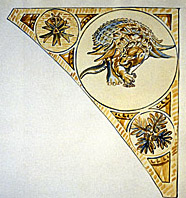 |
6. Edmontonia (Nodosaurid dinosaur). Named after Edmontonia geological formation. Fossils found in Alberta and U.S.A. Flanked by transverse section of magnolia blossom above and breadfruit (Artocarpus communis) below. |
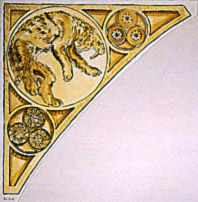 |
7. Smilodon
(sabertooth tiger). Pleistocene era. Southern Alberta and throughout
the Americas. Earthstar fungi above and below. (not shown) 8. Mammuthus (wooly, or hairy, mammoth). Late Pleistocene. British Columbia to Ontario and Nova Scotia to Georges Bank. Snowflake patterns above and below remind us that Smilodon and Mammuthus lived in the ice age. |
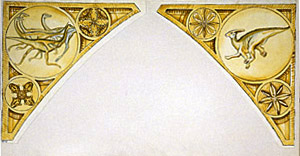 |
Left: 9. Struthiomimus
(carnivorous ostrich-like dinosaur). Late Cretaceous. Fossils found
in Alberta, Saskatchewan and U.S.A. Elephant ear leaves (Gunnera)
above and 4 grains of pollen (Aquilapollenites) below. (Link
to an online article by D. Jarzen who first identified Aquilapollenites is
at the bottom of this page.) Right: 10. Parasaurolophus (crested, duckbilled dinosaur). Late Cretaceous. Found in Alberta and the U.S.A. Magnolia buds and leaves above and below. |
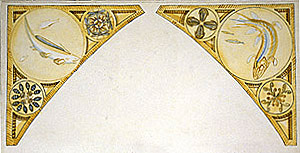 |
Left: 11. Xenacanthus
(cartilaginous fresh water shark). Spread to lakes and rivers all
over the world. Known from Late Carboniferous fossils in Nova Scotia.
Giant dragonflies above (Meganeura monyi) had a wingspan of 70 cm.
The lower roundel has a relief of Sigillaria, a genus of
extinct treelike club mosses. Right: 12. Eusthenopteron (primitive fish). Considered to be the direct ancestor of amphibians. Late Devonian fossils found in Québec. Trilobite marine animals above with prehistoric plant from the common horsetail (Equisetaceae) family below. |
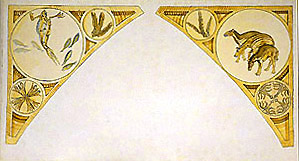 |
Left: 13. Hesperornis
(flightless loon). Late Cretaceous. Fossils are known from Northwest
Territories, Alberta, Saskatchewan and the U.S.A. Plant species
Junermannia trichomonis of bryophytes above. Giant club moss
bull-rushes below. Right: 14. Hyracotherium (early equid ancestor of the horse). Early Eocene. Widespread in Europe and North America including Arctic Canada (Ellesmere Island). Metasequoia occidentalis the dawn redwood is above, while Postelsia palmaeformis, the Pacific sea palm is in the lower roundel. |
Reference: Evolution of Life Series pamphlet from the Office of the Curator House of Commons.
EXTERNAL LINKS:Illustrated article with references, by one of the consultants for the Origin of Life in Canada carvings, David M. Jarzen, Canadian Museum of Nature, Ottawa.
Tyrrell Museum in Alberta.
Enchanted Learning. Dinosaurs and fossils in Canada.
Back to Origin
of life in Canada Album page.
Back to Parliament Gallery
page.